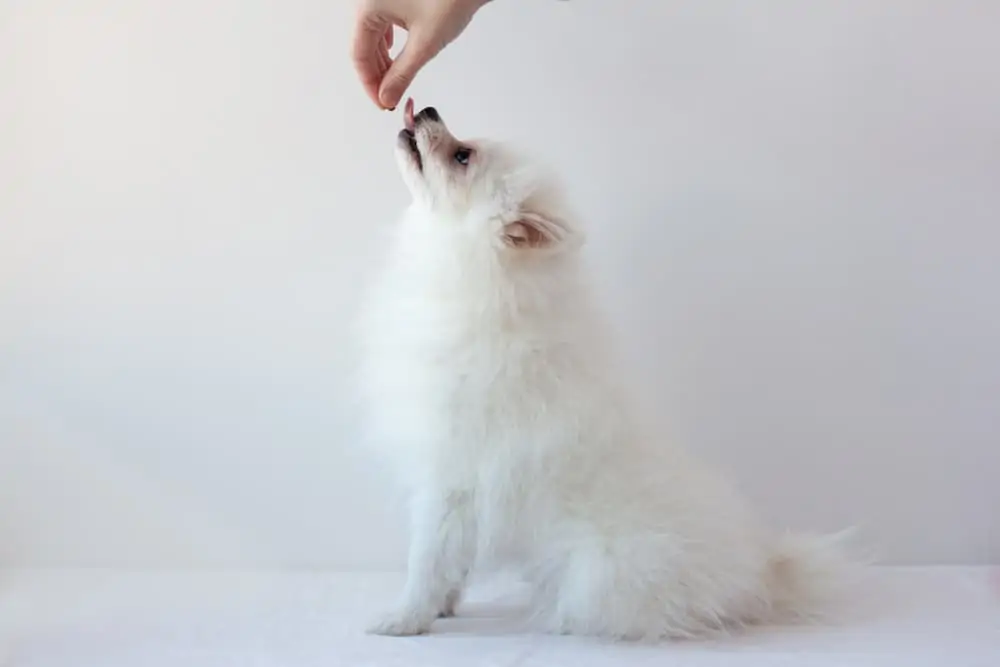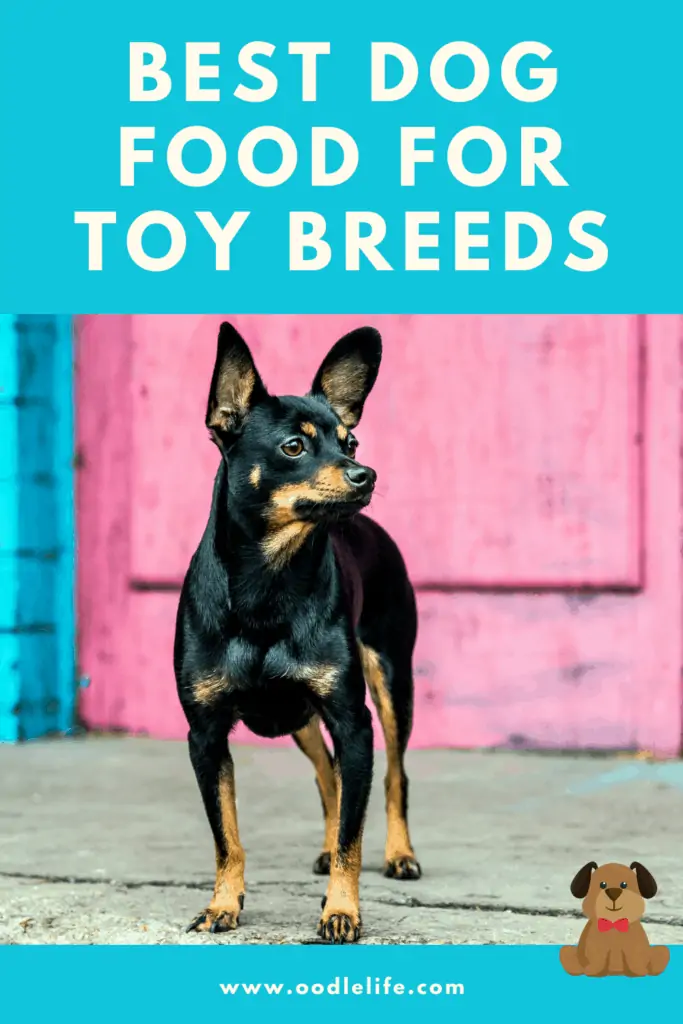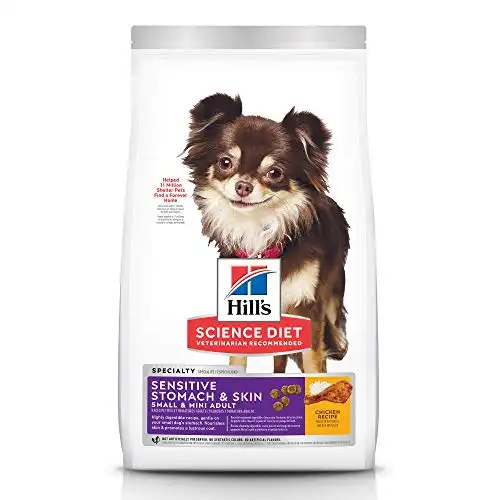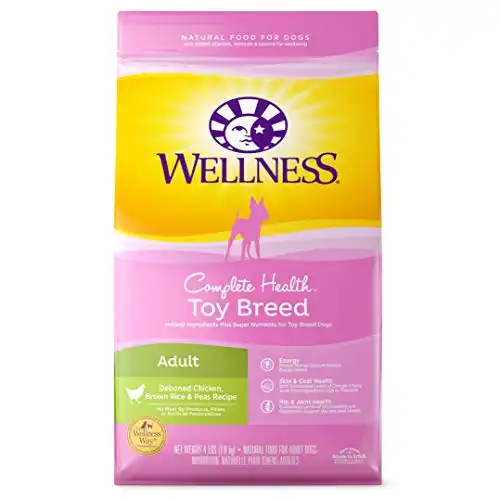Best Dog Food for Toy Breeds
Finding the right dog food for your toy breed can be tricky, especially because there is so much choice on the market.
Even though they require less food, toy breeds still require a nutritious diet to ensure that they stay as healthy as possible and can enjoy the best quality of life.

Lower-quality foods are often packed with fillers and by-products that have next to no nutritional value, and won’t support your pup through fundamental stages of growth.
If you don’t choose the best dog food for your toy breed, then, you could be putting your dog at risk of developing a wide variety of health issues.
To ensure that your toy breed gets the right balance of nutrition and to simultaneously save yourself a large vet bill, it’s essential that you get their diet right.
Keep reading to find out the best dog food for toy breeds.
1. Hill’s Science Diet Dry Dog Food, Adult, Small & Mini Breeds, Sensitive Stomach & Skin, Chicken Recipe, 4 lb Bag
The Hill’s Science Diet Dry Dog Food is formulated with little dogs in mind to provide an optimal balance of nutrients specifically for miniature and toy breed dogs.
The vitamin E, omega 6 fatty acids, and other nutrients in this smaller kibble help to nourish skin and promote a lustrous coat.
This dog food is designed for sensitive stomachs, has protein as the first ingredient, and uses prebiotic fiber to feed your small dog’s microbiome for optimal digestive health.
Pros:
- No.1 Veterinarian recommended – So you don’t have to worry about whether your dog is receiving the right kind of nutrients.
- Natural ingredients – Formulated with decades of cutting-edge research to be a great tasting dog food small dogs can easily digest and truly enjoy.
- Small kibble – Designed to make it easier for your toy breed to properly eat and chew their food.
Cons:
- One customer noted that the packaging of this particular dog food could be improved.

2. Purina Pro Plan High Calorie, High Protein Toy Breed Dry Dog Food, Chicken & Rice Formula – 5 lb. Bag
The Purina Pro Plan High Calorie High Protein Toy Breed Dry Dog Food is made with natural prebiotic fibers that are designed to nourish specific intestinal bacteria for digestive health.
This dog food is high in protein, with chicken as the number #1 ingredient, to meet the needs of highly active toy breed dogs!
Fortified with guaranteed live probiotics for digestive and immune health, this dog food formula features bits of bite-sized kibble that are easy for your toy breed to chew and a delicious flavor that makes meals fun.
Pros:
- Specially formulated – Designed for adult toy-breed dogs, offering specialized nutrition created with your dog in mind.
- Bite-sized kibble – Designed for your toy breed to easily chew and digest this delicious dog food.
- Fortified with probiotics – Guaranteed live probiotics are used to support digestion and immune health.
Cons:
- One customer noted that their dog seemed lethargic after eating this particular dog food.
3. Wellness Complete Health Natural Dry Toy Breed Dog Food, Chicken & Rice, 4-Pound Bag
The Wellness Complete Health Natural Dry Toy Breed Dog Food is made with high-quality proteins and wholesome grains that are expertly balanced to deliver a complete diet packed with the nutrients your toy breed dog needs to thrive.
Wellness Complete Health Dry Dog Food is packed full of blueberries that are rich in vitamin A & C, potassium, fiber, and various carotenoids, making this food antioxidant-rich to support strong immune systems.
This dog food for toy breeds supports your dog’s balanced natural nutrition, with the balanced nutrients promoting optimal energy and the guaranteed levels of omega fatty acids ensuring a healthy skin and coat.
Pros:
- Made in the USA – Using only the finest globally-sourced ingredients that are wholesome, non-GMO, and specifically chosen for their nutritional benefits.
- Natural – This dog food is free from meat by-products, fillers, and artificial preservatives, so your dog can easily digest it and you can feed your pooch with confidence that there are no hidden nasties.
- Small kibble – The Wellness smaller kibble size is specifically made with smaller mouths in mind, so your toy breed won’t struggle to eat it.
Cons:
- A few customers claimed that their dogs were slow to adapt to this particular dog food.
4. Blue Buffalo Wilderness High Protein, Natural Adult Toy Breed Dry Dog Food, Chicken 4-lb
The Blue Buffalo Wilderness High Protein Natural Adult Toy Breed Dry Dog Food contains carefully balanced protein and carbohydrates that help fuel your dog’s active lifestyle!
This formula contains BLUE’s exclusive LifeSource Bits – a precise blend of antioxidants, vitamins, and minerals carefully selected by holistic veterinarians and animal nutritionists to support immune system health, life stage requirements, and a healthy oxidative balance.
This grain-free toy breed dog food is made with the ingredients to help meet a small breed’s higher energy requirements, with a special “small bite” kibble ideal for smaller jaws and to aid digestion.
Pros:
- Small kibble – Specially formulated for toy breed dogs with a small-bite kibble to help remove tartar with chewing.
- High-quality protein – Designed to support your toy breed’s high-energy needs.
- Natural ingredients – Features the finest natural ingredients enhanced with vitamins and minerals, free from chicken (or poultry) by-product meals, corn, wheat, soy, artificial flavors, and preservatives, so you don’t need to worry about putting your trust into this food.
Cons:
- A couple of customers noted that the kibble was smaller than they were anticipating.
- PACKED WITH REAL CHICKEN: A recipe made to satisfy your dog’s natural love for meat, this high protein dog food features real chicken to help build and maintain lean muscle mass
- HEALTHY INGREDIENTS: BLUE Wilderness grain free toy breed dog food is made with the ingredients to help meet a small breed’s higher energy requirements with a special “small bite” kibble ideal for smaller jaws
- ANTIOXIDANT-RICH LIFESOURCE BITS: A precise blend of antioxidants, vitamins and minerals carefully selected by holistic veterinarians and animal nutritionists to support immune system health, life stage needs and a healthy oxidative balance
- A NATURAL DOG FOOD: BLUE dry dog food is made with the finest natural ingredients enhanced with vitamins and minerals; BLUE contains NO chicken (or poultry) by-product meals, corn, wheat, soy, artificial flavors or preservatives
- Contains one (1) 4-lb bag of BLUE Wilderness High Protein Natural Adult Toy Breed Dry Dog Food, Chicken
5. Instinct Raw Boost Toy Breed Grain Free Recipe with Real Chicken Natural Dry Dog Food by Nature’s Variety, 4 lb. Bag
The Instinct Raw Boost Toy Breed combines high protein, grain-free kibble with all-natural bites of freeze-dried, cage-free raw chicken as the #1 ingredient.
This dog food is made with calcium & phosphorus for strong teeth and bones plus glucosamine & chondroitin for joint health.
Instinct proudly represents raw, less processed food. From 100% raw frozen recipes to freeze-dried raw coated kibble, they’re helping pet parents find a variety of ways to incorporate raw into their pet’s diet!
Pros:
- Grain free – Made without grain, potato, corn, wheat, soy, by-product meal, artificial colors, or preservatives that might upset your pup’s stomach or trigger food sensitivities.
- Raw, natural ingredients – This food is natural, made from real meat & whole food ingredients, protein-packed, and is minimally processed, keeping valuable nutrients intact and meaning it is great for your pup’s stomach!
- Nutrient-dense – This raw, uncooked food retains natural flavors, antioxidants, amino acids, vitamins, and minerals that are important for your dog’s development.
Cons:
- One customer claimed that their dog seemed fussier after being given this food.
Best Dog Food for Toy Breeds Buyer’s Guide
There are a few factors to take into consideration when choosing a dog food for your toy breed, but it mainly comes down to proteins, your feeding schedule, and any health issues that your toy breed may have.
You should always ensure that the dog food that you’re buying for your toy breed is of good quality. This is because lower-quality foods are often packed full of fillers that contain little nutritional value.
As toy breeds are high-energy dogs that metabolize food more quickly, you will need to choose a food with a high protein and moderately low carbohydrate content to ensure that they have enough energy, but don’t become overweight.
Check out the factors below before making your purchase.
Proteins (The Toy breed Ratio)
One of the most important factors that you will need to take into consideration when choosing dog food for your toy breed is the protein content.
As smaller dogs have smaller stomachs, their diet needs to be of high quality, and high protein is an excellent way of ensuring that your dog has a high-quality diet to satisfy their high-energy needs.
Toy breed dogs thrive on a high to moderate protein diet. They cannot eat a large volume of food all at once due to the fact they have smaller stomachs, therefore, the food that they eat needs to be high in nutrients.
This doesn’t mean that you’re limited to buying only high-protein foods, unless your veterinarian recommends it or if your dog is young.
However, a good place to start is to buy dog food that contains between 24%-36% of protein for your toy breed.
Toy Breed Feeding Schedule
It is worth noting that you should always consult your veterinarian before making a feeding schedule for your toy breed dog.
Generally speaking, toy breeds will need to be fed around 4 to 6 meals per day for the first three months of their lives. However, this is subject to change depending on the breed and age of the dog.
It is worth noting that puppies are highly energetic and will require more protein than an elderly toy breed dog that has become less active as they’ve grown older.
Taking all of this into account, consulting with your veterinarian is your best bet for figuring out the best feeding schedule for your dog.
They’ll be able to offer you advice on your initial feeding schedule and can help you alter it as your dog grows. This is generally the safest option to know that your dog is getting the right amount and balance of nutrients.
The most important thing to remember is that consistency is key when it comes to a feeding schedule for your toy breed dog.
Small dogs are quite often known for having sensitive stomachs, so if you’re considering changing your toy breed’s diet, it is important that you do this gradually and slowly.
This will give your dog the chance to adapt to their new food and give you the opportunity to notice if anything seems out of the ordinary, such as a food or skin allergy as a result of the food that you’ve bought.
Patience is key when it comes to switching up your dog’s diet. After all, we all want the best for our furry friends and it is our job to make sure that they are as happy and as healthy as possible.
Health Issues Specific to Toy Breeds

When choosing food for your toy breed, you will also want to take into account any health issues that your dog can be prone to developing, as their diet can significantly affect this.
Although having a small dog is thought to be fashionable in the media, there are certain health issues that contribute to their maintenance that you need to be aware of.
Small dogs and toy breeds often have sensitive stomachs or have allergies to certain ingredients. As a result, you’ll need to feed them several times a day and take extra care with what you feed them to avoid any stomach upset or sensitivities.
Toy breeds are especially prone to digestive issues, so you will need to ensure that you buy food with natural, easily digestible ingredients.
The clue is in the name, toy breeds are tiny, and they are also very fragile as a result of this. For instance, simple tasks such as jumping off the couch, which usually wouldn’t pose a threat for a cat or larger dog, can be a huge undertaking and can also be very dangerous for a toy dog.
A jump or fall from just a few feet can easily result in broken bones. You will also want to be aware of knee joint displacement and Legg Calve Perthes disease, which is an obstruction of blood between the femur and hip joint that causes the bone and joint to deteriorate over time.
You will also want to do your research on Brachycephalic Obstructive Airway Syndrome. This condition is common in some breeds, such as pugs, and means that they have trouble breathing.
Their respiratory systems are compressed, which subsequently makes it harder for them to take deep breaths.
Hydration for Toy Breeds
A big factor to consider when purchasing dog food for your toy breed is hydration. How much water your dog will need will largely depend on their activity in a day.
Although dry kibble is great for your toy breed’s teeth and keeping plaque at bay, it is significantly less hydrating than wet food.
Toy breeds, such as Chihuahuas, Pomeranians, and Yorkies can be prone to dehydration, especially in hot weather. Whereas wet food is generally made up of 80% water, dry kibble usually measures around 20%.
As a result, if you decide to feed your toy breed dry kibble, you will also need to ensure that your dog is getting enough water throughout its day.
As we’ve mentioned, how much water they’ll need will vary depending on their activity levels, but they should always have water readily accessible to them in bowls around the house.
If you find that your toy breed is fussy about eating the dry kibble alone, you could always try incorporating wet food into their food to make it more palatable for them.
The aromas from the wet food will hopefully tempt them to the bowl, whilst also providing them with an extra boost of hydration, too.
Consult Your Veterinarian

It is important to note that you should always consult with your veterinarian before making any drastic changes to your dog’s diet.
Although you might initially think that getting a toy breed is less effort than a bigger-sized dog, you shouldn’t be lulled into a false sense of security. Toy breeds take as much, if not more maintenance to ensure that they are as healthy and as happy as possible.
As with many smaller-sized dogs, toy breeds tend to have sensitive stomachs and digestion problems due to the size of their stomach.
A veterinarian will be able to offer you advice on your specific breed, tell you which foods or ingredients to avoid buying, and what to look out for when it comes to allergic reactions.
Frequently Asked Questions
What is the best dog food for toy breeds?
The answer to this question is largely subjective, as every dog is different and will have different requirements depending on factors such as their breed and age. However, when it comes to choosing dog food for your toy breed there are a few things to look out for.
Namely, your toy breed will need a high-protein, low-carbohydrate diet to help maintain their energy due to their high metabolism, but to ensure that they don’t become overweight and develop conditions such as diabetes.
The dog food that you choose should also contain essential nutrients such as vitamins, minerals, and antioxidants to ensure that they remain as healthy as possible as they age.
How much should I feed my toy breed dog?
The answer to this question is likely to differ depending on who you consult. The exact amount of food your dog requires will need to be adjusted according to age, activity, and environment.
However, generally speaking, a good place to start is knowing that toy breed dogs need to eat little and often.
The number of times you feed your toy breed in a day is subject to change as your dog grows, and this will likely come down to trial and error.
However, in doubt, you must always ask your veterinarian for advice when it first comes to making a feeding schedule for your pup, as you don’t want to be in a situation where you’re either not feeding your dog enough or are feeding them too much food.




